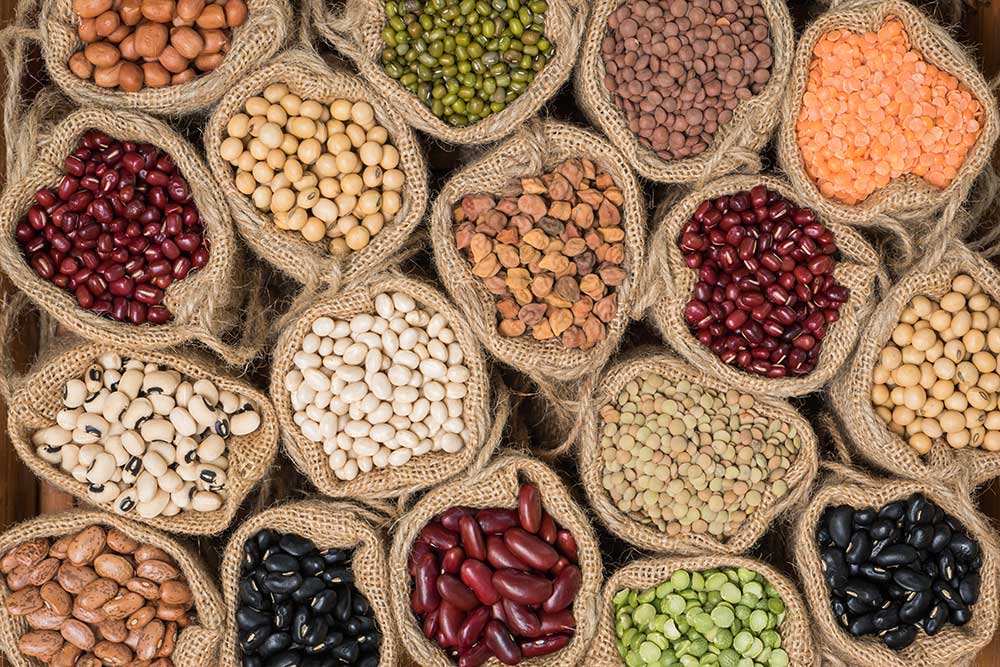Why choose legumes?
Whether you prefer eating them as a simple side dish, dressed with oil and rosemary, using them for preparing vegetable soups or purées, or better still for accompanying pasta dishes, legumes are an important dietary resource: beans, chick peas and lentils contain a lot of proteins, iron, mineral salts (phosphorus, potassium, calcium. zinc, magnesium) and antioxidants such as flavonoids and phytic acid. Their nutritional contribution is considerable due to their high amino-acids content, indispensable for synthesising the proteins needed by the body. If you are undecided about whether to buy a packet of legumes or a tin, some additional information will be useful.
First of all, in proportion, the former are usually cheaper and this is even more true if we consider that legumes must be left to soak before being prepared and therefore, after they have been cooked, they increase in volume considerably and go much further: in fact, legumes must be cooked in double their volume of water because most of the liquid is absorbed; moreover, they are covered in a skin mainly composed of fibres which, already, while they are soaking, become swollen with water, just like the grains of starch of which they are composed.
After being cooked and dressed with extra-virgin olive oil, legumes can be preserved for up to three days in the fridge. Legumes can also be ground to obtain gluten-free flour, useful for preparing pancakes, omelettes and cakes; the sweeter black beans can also be used for preparing creams, perhaps together with cocoa powder or dried fruit.
Some people may find legumes difficult to digest and may exclude them from their everyday diet for this reason: a trick to reduce this “side effect” of eating legumes is to add some powdered ginger, some bay leaves or a sprig of rosemary while they are cooking; the addition of a teaspoon of baking powder while they are soaking also helps to prevent the production of intestinal gases.
Secrets for cooking legumes successfully
When we try preparing legumes for the first time, sometimes we get the soaking times and cooking times and methods wrong, with the result that the pulse remains rather hard and difficult to swallow. In fact, if the starch contained in the pulse has not absorbed a sufficient amount of water while it is soaking, the granules which are still dry, can become a compact mass while they are cooking which does not allow the water to penetrate, especially if the temperature goes up too quickly. To obtain a perfect result, therefore, a long soaking time and slow, gradual cooking are fundamental. You should also avoid cooking the legumes in an acidic environment which keeps their fibre hard.
So, to sum up, here are the basic steps to be followed:
- soak the legumes in cold water for several hours;
- strain, rinse and pour into a saucepan with a thick bottom filled with water;
- increase the temperature slowly and boil on a low heat;
- add any acidic condiments only when the legumes are almost cooked.
Here are all the types of legumes
The following legumes can be found in the shops fresh, frozen, dried or in tins:
- peas. They are sweeter than other legumes due to their higher content of simple sugars; they are some of the legumes that contain the fewest calories and dried ones take longer to cook than other legumes;
- lentils. They cook faster because they are small and are rich in fibres and iron;
- beans. A huge variety of different beans exist and the dried ones include borlotti, very rich in fibres, lecithin and iron;
- fava beans. Poor in fats, they are rich in vitamin B1 and folic acid but they must not be eaten by anyone suffering from favism
- chick peas. They are more digestible than other legumes because they stimulate the production of gastric juices and pancreatic enzymes;
- soya beans. Very well-known and used above all by vegans, they are the best meat substitute because they are rich in proteins and phytoestrogens.
Legumes: not only in cooking!
Did you know that the water used to soak legumes can be used later to water your plants? This is only one of the many “tips” concerning this food, rich in properties and also useful outside the kitchen. In fact, legumes in their raw state can be used for preparing games to entertain children. By recycling waste materials and old containers such as yogurt pots, for example, you can create rudimentary maracas by filling them with legumes, and they can also be perfect for stuffing hand-sewn rag dolls. And how can we forget the tradition of using legumes at Christmas to cover the numbers on our cards while we are playing bingo?
Another household use, on the other hand, could be as a substitute for an ice pack, filling a cushion cover with small legumes and leaving it to cool in the freezer before taking it out when needed.
Sources:
- Green Me
https://www.greenme.it/ - Life Gate
https://www.lifegate.it/persone - Sale e Pepe
http://www.salepepe.it/ - Depurarsi
https://www.depurarsi.com/




